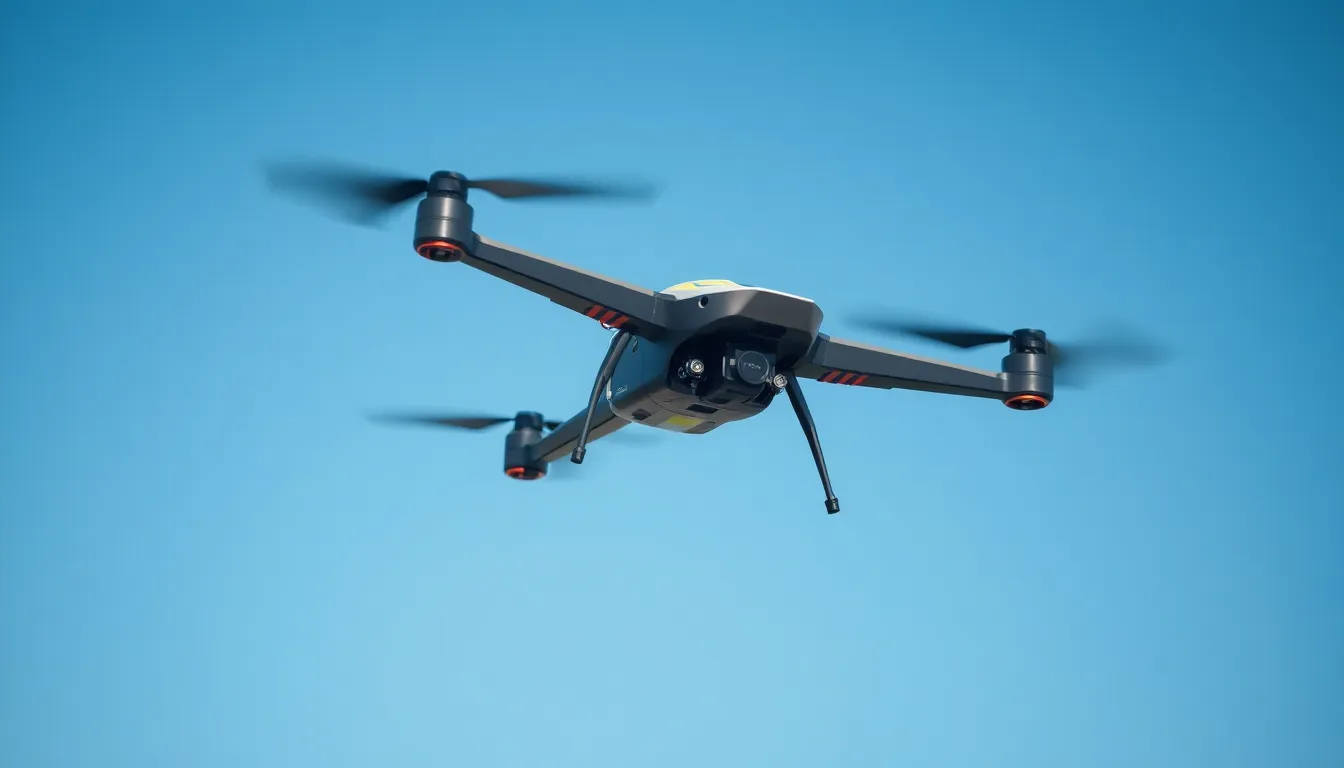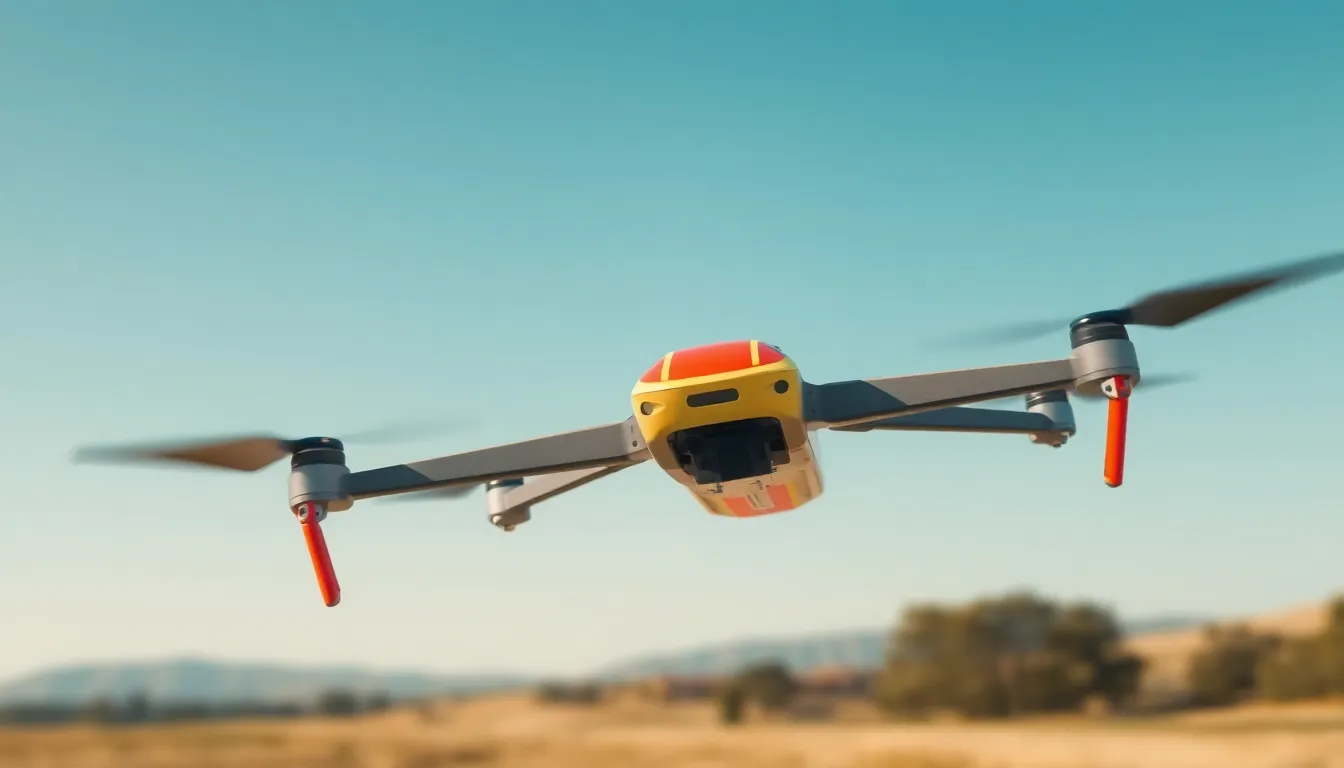Drones are the new superheroes of the skies, zipping through the air like they’re late for a very important date. With their sleek designs and high-tech features, it’s no wonder people are curious about how fast these flying gadgets can really go. Spoiler alert: they can fly faster than your average cat can run away from a bath!
Table of Contents
ToggleOverview Of Drone Speed
Drones exhibit varying speeds based on their design and intended use. Racing drones can reach speeds up to 100 miles per hour, making them some of the fastest on the market. Consumer drones, typically used for photography, and videography, have average speeds between 15 to 50 miles per hour.
Military drones, engineered for surveillance and combat, often achieve higher speeds, often exceeding 60 miles per hour. The MQ-9 Reaper, a well-known military drone, can fly at speeds around 276 miles per hour. Speed maintains its importance in specific applications such as search and rescue missions, where quick deployment can save lives.
High-speed drones rely on advanced materials and aerodynamics. By minimizing drag, manufacturers enhance performance, enabling faster flight. Battery capacity influences speed as well; larger batteries provide more power but can add weight.
Payload restrictions impact overall speed. Heavier loads decrease acceleration and may hinder agility. In contrast, lightweight drones frequently excel in speed maneuvers.
Emerging technologies continue to innovate drone speed capabilities. Hybrid drones combine traditional design with vertical takeoff and landing functionality, allowing for enhanced speeds and efficiency. Keeping up with these advancements showcases the dynamic nature of drone technology and its rapid evolution in aerial capabilities.
Understanding drone speed is essential for selecting the right model based on purpose. A pilot’s needs determine the choice between speed and stability.
Factors Influencing Drone Speed

Drones exhibit varying speeds influenced by several important factors. Weight, design, battery life, and environmental conditions all play significant roles in determining how fast a drone can fly.
Weight and Design
Weight greatly impacts drone performance. Heavier drones struggle with acceleration and overall speed. Design elements such as aerodynamics enhance flight efficiency. Racing drones, designed for speed, feature lightweight materials, which allow them to fly up to 100 miles per hour. Conversely, consumer drones prioritize stability and ease of use, which can limit speed to 15 to 50 miles per hour. Thus, the construction of a drone directly affects its maximum velocity.
Battery Life
Battery life affects how long a drone can operate at high speeds. Limited battery power restricts thrust and can result in slower speeds. Drones with larger batteries typically sustain faster speeds for longer durations. Additionally, battery weight matters; a heavier battery can hinder flight dynamics. Efficient energy management contributes to performance, allowing units like racing drones to maintain their top speeds during competitions. Thus, battery capacity and efficiency are crucial to a drone’s speed capabilities.
Environmental Conditions
Environmental conditions can impact drone speed significantly. Wind resistance acts as a primary factor; strong winds can slow down a drone’s velocity. On calm days, drones can achieve maximum speeds with less drag. Altitude also plays a role; flying higher can decrease air density, which may either enhance or hinder flight performance depending on design. Weather elements such as rain can lead to reduced speed due to increased resistance. Therefore, pilots should consider these conditions before flights to optimize their drone’s performance.
Types Of Drones And Their Speeds
Drones come in various types, each designed for specific applications, resulting in different speed capabilities.
Consumer Drones
Consumer drones are popular for hobbies and personal use. Typically, these drones achieve speeds ranging from 15 to 50 miles per hour. Brands like DJI and Parrot dominate the market, producing models that prioritize ease of use and stability. For instance, the DJI Mini 2 can zip through the air at 36 miles per hour, making it suitable for casual photography and fun flights. Battery capacity remains a key aspect, as enhanced battery life allows for extended flight times and maintaining speed.
Racing Drones
Racing drones are built for speed, emphasizing agility and quick response times. These specialized drones can reach impressive speeds of up to 100 miles per hour in competitive settings. Their lightweight frames and powerful motors enhance acceleration, enabling pilots to navigate complex courses rapidly. Customizable components play a significant role, allowing enthusiasts to tweak propulsion systems for maximum performance. Events like the Drone Racing League showcase these high-speed machines in action, appealing to adrenaline junkies and tech-savvy spectators.
Military Drones
Military drones are designed for intelligence, surveillance, and combat operations. The MQ-9 Reaper, a well-known example, can fly at speeds of about 276 miles per hour. These advanced drones incorporate cutting-edge technology, allowing for extended range and quick deployment. Performance metrics significantly depend on mission specifications and payload requirements. The high-speed capability enhances situational awareness and responsiveness in critical situations, emphasizing the strategic advantage they provide on the battlefield.
Technological Advances In Drone Speed
Technological innovations significantly impact the speed capabilities of drones. Advances in motor technology and aerodynamics enhance performance in various applications.
Motor Technology
Brushless motors play a vital role in achieving high speeds. These motors deliver more power and efficiency, resulting in faster acceleration and greater overall velocity. Designers often choose lightweight materials to construct motors, which contributes to improved speed metrics. Innovations in battery technology further augment motor performance, enabling higher thrust and sustaining rapid flight durations. Manufacturers continuously refine these components, providing quicker response times and improved reliability in demanding environments.
Aerodynamics Enhancements
Aerodynamic design directly influences a drone’s speed. Streamlined shapes reduce drag, allowing drones to glide through the air more efficiently. Manufacturers apply sophisticated computational fluid dynamics in design processes to optimize airflow. Cutting-edge materials, such as carbon fiber and advanced composites, decrease weight while maintaining structural integrity. Wing designs are now engineered not only for stability but also for speed, enabling drones to achieve impressive velocities in various conditions.
Real-World Applications Of Drone Speed
Drones exhibit diverse speed capabilities across various applications, enhancing efficiency and effectiveness in numerous fields.
Delivery Services
Delivery drones optimize logistics by reducing transport times. Some models achieve speeds up to 50 miles per hour, facilitating rapid deliveries, especially in urban areas. Businesses leverage this capacity to meet consumer demand, ensuring packages arrive promptly. Companies like Amazon and Wing utilize drones for last-mile delivery, showcasing speed’s pivotal role in operational success. Optimization in battery life and lightweight materials allows these drones to navigate through urban traffic efficiently, making them game-changers in the delivery industry.
Search And Rescue Operations
Search and rescue missions demand speed to save lives. Drones equipped for these operations can fly swiftly, often exceeding 60 miles per hour, allowing responders to reach critical areas quickly. Teams deploy drones to cover large search areas more efficiently than ground teams. Additionally, real-time aerial footage aids in assessing situations promptly, enhancing decision-making. Organizations like FEMA and local rescue squads embrace drone technology to improve response times drastically, making a significant difference in emergency scenarios. Effective use of drones in such high-stakes environments illustrates the importance of speed in life-saving contexts.
Drones have transformed the landscape of aerial technology with their remarkable speed capabilities. From racing models that zoom through the air to military drones designed for strategic advantage, speed plays a critical role in their functionality.
As advancements in materials and motor technology continue to evolve, the potential for increased speed is limitless. Understanding the various factors that influence drone velocity allows users to make informed choices tailored to their specific needs.
In a world where efficiency and rapid response are paramount, the speed of drones is more than just a number; it’s a game-changer across multiple industries.


